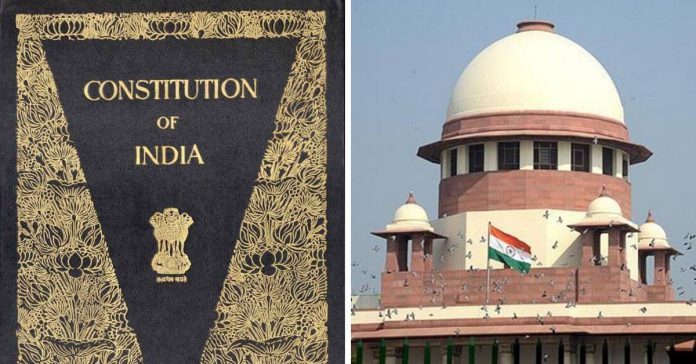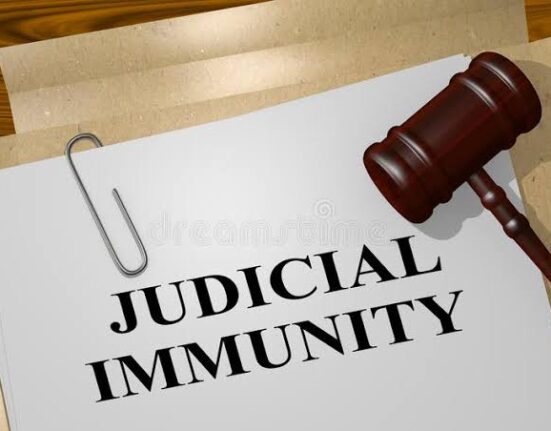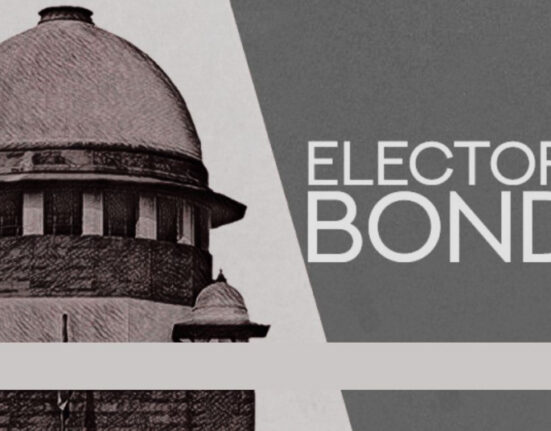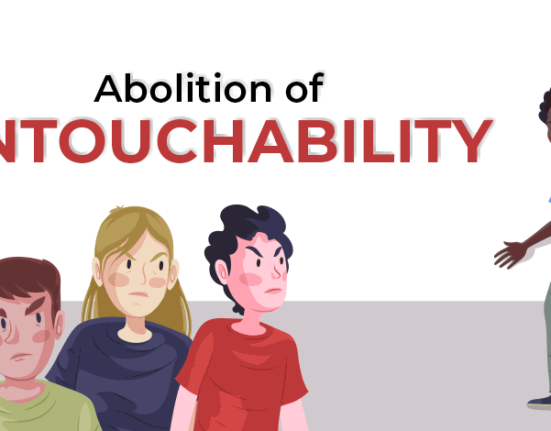Shad Khan, a 2nd-Year, School of Law, DAVV Indore Student has written this Article “Article 124: Composition, Appointment, and Impeachment of Judges”.
Supreme Court – The Guardian of the Constitution
The separation of authority between the federal government and the states is the crux of the federal constitution. The constitution, which is the supreme law of the state, is what creates the separation. It is natural for disputes to arise as a result of different interpretations by various authorities at various times. Therefore, to uphold the supremacy of the Constitution, there must be an independent and impartial authority to settle disagreements between the federal government and states, or between the states themselves.
The Supreme Court serves as a final interpreter and arbitrator in all disputes, also the guardian of the Constitution as the highest court of appeal in civil and criminal cases. “It is the greatest tribunal which has to draw the line between individual liberty and social control.”[1]
History
Formerly, the Federal Court, established by the Government of India Act of 1935, was regarded as India’s highest court because of the way it was set up during British control. The Supreme Court was then founded in 1950, replacing the federal court. The constitution, which is the supreme law of the state, has provisions that must be followed to the letter of the law. The provisions incorporated into the constitution are useless without the application of the law. As a result, the judiciary is free to interpret the Indian Constitution’s clauses. As the supreme court of the nation, the Supreme Court upholds fundamental rights while operating within the confines of the Constitution.
Constitution Of Supreme Court
The Supreme Court of India is the country’s highest court. The Supreme Court stands at the head of the judicial system of India. The expression ‘Union Judiciary’ is to some extent a misnomer, because, under our Constitution, the Union shall have no judiciary separate from that of the State. Accordingly, as stated in Entry 77 of List I, Schedule VII of the constitution, the constitution, organizations, jurisdiction, and power of the Supreme Court shall be subject to the constitution and governed by the union legislative. There is no article in our Constitution as same in the American Constitution that vests the judicial power of the Union in the Supreme Court.[2]
Composition of Supreme Court
A chief justice and no more than 7 more judges make up the Supreme Court of India until a higher number may be prescribed by law by parliament. Although there were initially 7 judges in total, there were several changes over time. Recently witnessed a rise in the number of judges, excluding the chief justice, to 33. Thus, including the Honorable Chief Justice, there are currently 34 judges in total.[3]
Fixation Of The Number Of Judges
According to Art. 216 of the Constitution, the President determines the number of judges to be appointed to the High Court. The minimum number of judges required to form a bench for a hearing is not specified by the Constitution. However, the Constitution requires that at least five judges deliberate on constitutional issues. It can also be deduced from Articles 145(3) and 143 that the strength cannot be fewer than five.
The number of judges to be appointed to each High Court has been left up to the Executive’s discretion. The only thing that may be suggested is an amendment of Art. 216 of the Constitution to bring it in line with Art. 124(1), so that Parliament gets a chance to make a periodical review of the strength of the different High Courts as that of the Supreme Court.
Appointment Of Judges of The Supreme Court
Before the 99th Constitutional Amendment Act
The president appoints the Supreme Court’s judges. The president chooses the Chief Justice of the Supreme Court after consulting with the High Court and Supreme Court Judges he felt were necessary for the position. But the president would always seek the Chief Justice of India’s approval before appointing further justices. According to this article, the executive was expected to communicate with those who are expertly prepared to provide sound counsel on judge nomination matters.[4]
After the 99th Constitutional Amendment Act
Articles 124, 127, and 128 of the constitution were revised by the 99th Amendment Act of 2014, which includes 124(A), 124(B), and 124(c). According to the law, the president must issue a warrant with his signature and seal before appointing any Supreme Court justices on the National Judicial Appointments Commission’s proposal. It is the duty of NJAC to recommend appointment as well as the transfer of CJI, Judge of Supreme Court, Chief Justice of High Court, and other judges of the High Court. Also to ensure that the person recommended is of ability and integrity.[5]
Composition of NJAC[6]–
- Chairperson – Hon’ble Chief Justice Of India, ex officio
- Members – Two other senior judges of the supreme court, ex officio
- Member – The Union minister in charge of Law and Justice, ex officio
- Two eminent persons to be nominated by the committee
NJAC was immune from being questioned or invalidated.
Justice Adarsh Ku. Goel held– “The new scheme damages the basic feature of the constitution under which primacy in the appointment of judges has to be with the judiciary. Such primacy has been given a go-by and therefore the amendment cannot be sustained. NJAC cannot survive once the amendment is struck down and the pre-amendment scheme of appointment of judges stands revived.”[7]
Nature of power to appoint
1. It is an ‘executive’, not quasi-judicial function.”[8]
2. When compared to the opinions of other constitutional officials, it was determined that the Chief Justice of India’s opinion did not follow the letter of the Constitution but rather ran counter to the very nature of the subject matter involving the judiciary and the context in which “consultation” was required. Furthermore, it was recognized that nothing in Articles 124 and 217 specifically mandates that the President consult the administration in this way. The viewpoint reached during discussions with the collegium is referenced in the Chief Justice’s decision[9].
3. In the case of non-appointment of a recommendation of the Chief Justice of India, if there are positive materials indicating his appointment to be otherwise unsuitable. The Chief Justice of India does not have the primacy to persist for the appointment of that recommendation.
Whether Article 16(4) applies to the appointment of judges under Article 124(2)?
Because judges of these higher courts hold “constitutional offices,” the clause in Art. 16(4) for reservations for members of the backward classes does not apply to their appointment. They do not have any “appointment or post” with the State, nor they are “government servants.”[10]
Additionally, the general requirements in Arts. 15(4) and 16(4) should not be relevant to the provisions in Arts. 124 and 217, which are unique provisions relating to the appointment of certain positions.
Thirdly, Art. 16(4) does not grant any rights; it merely acts as an enabling clause.[11]
Retirement
The age of superannuation of a Supreme Court Judge is 65, under Article 124(2).
Resignation
A Supreme Court justice may resign from the bench at any moment, prior to retirement or dismissal, by sending a letter to the president in that regard. The resignation does not have to be recognized in order to be accepted. This clause and proviso (a) of Article 217(1), which deals with High Court Judges’ resignation, are both applicable to Supreme Court Judges. In Union of India v. G.C. Misra,[12] It was held that a High Court Judge can withdraw his resignation before it becomes effective. A prospective resignation can be withdrawn, but not when the resignation is present It was held that the Constitution does not bar such withdrawal.
Qualification for appointment as Judge of the Supreme Court
A person to be qualified for appointment as a Judge of the Supreme Court must be a citizen of India:
(1) has been a Judge of a High Court at least for five years, (2) has been for at least ten years an advocate of a High Court. (3) is in the opinion of the President, a distinguished jurist.[13]
Thus, a non-practicing or an academic lawyer may also be appointed as a Judge of the Supreme Court. In India, so far, no non-practicing lawyer has been appointed as a Judge of the Supreme Court. There are precedents in America where nonpracticing lawyers had been appointed as judges of the American Supreme Court.[14]
Furthermore, Under Article 124 (6) Every person who is appointed as a Judge of the Supreme Court before entering upon his office has to make and subscribe to an oath or affirmation before the President, or some other person appointed on that behalf by him.
Removal Of Supreme Court Judge
The Constitution does not prescribe any fixed tenure for the office of a Supreme Court Judge. Once appointed the office of a Judge of the Supreme Court may terminate only in one of three ways- (i) On attaining the age of 65 years.
(ii) On resignation in writing addressed to the President.
(iii) On removal by the President upon an Address by each House of Parliament.
The sole grounds for presenting the Address are “proven misbehavior” or incompetence by both houses during the same session.[15] Parliament must pass laws governing how to present an address, conduct investigations, and provide evidence of inappropriate behavior and incompetence. The President shall be required to remove that Judge if the addresses of both Houses are in accordance with these Clauses.[16]
The Judges (Inquiry) Act of 1968 should be read in conjunction with the aforementioned Constitutional provisions. The forced resignation of a judge is an unconstitutional way to remove them, which has an impact on the independence of the judiciary.[17] Moreover, Bar Council is not entitled to pass a resolution demanding a Judge to resign as it will shake the confidence and competence of Judges of integrity, ability, moral vigor, and ethical firmness, which in turn, sadly destroys the very foundation of a democratic polity.
“Misbehaviour“
The term “misbehavior” in the Constitution is not defined, but the ‘American experience’ supports the idea that it does not simply refer to a judge’s decisions being unpopular with the Legislature. Even the most egregious error in judgment does not qualify as “misbehavior.”Even mistakes in judgment or careless actions by the higher judiciary do not constitute misbehavior in and of themselves.[18]
Furthermore, Wilful abuse of judicial office, wilful misconduct in the office, corruption, lack of integrity, or any other offense leaving moral turpitude would be misbehavior. Misconduct implies the actuation of some degree of mens rea by the doer. A judicial finding of guilt of a grave crime is misconduct. However, Persistent failure to perform judicial duties of the judge or wilful abuse of the office dolus malus” would be misbehavior.
Procedure For Impeachment
Only if a motion addressed to the President is signed by at least 50 Members of the Rajya Sabha. Also, 100 Members of the Lok Sabha may begin the procedure for impeaching a Supreme Court judge. A committee of three members (two Judges of the Supreme Court and a distinguished jurist) will investigate this motion. Moreover, If the committee’s conclusion is adverse, the motion of impeachment will be withdrawn. However, If the report is in the affirmative then, the motion of impeachment together with the report of the committee shall be taken up for consideration by the House of Parliament which is pending after passing in each House by a two-thirds majority of the total membership of that House and by a majority of not less than 2/3 of the members of that House present and voting.
Then the address of Parliament for the Judge’s removal will then be given to the President during the same session. After the President issues his order for removal from the aforementioned address, the Judge will be dismissed.
Ban On Practice
There is a provision in the constitution that limits a judge of the Supreme Court who has held office from pleading or acting in any Court before any authority within the territory of India. This is done to protect the independence of the judiciary and reserve judicial powers from any sort of depression or coercion. [19]
Independence of Judiciary
India has a federal framework, a written Constitution, a Bill of Rights, and judicial review. Due to this, the Governments of the States and the Union of India are now the two parties that frequently file lawsuits before the Supreme Court and High Courts. The Government of India Act, of 1935 did not have the same protections for judicial independence that the Constitution has[20]. Moreover, According to Supreme Court justices, the Constitution’s fundamental framework of judicial independence is in jeopardy if it is altered in a way that compromises it. If this happens, the Constitution Amendment Act will be declared invalid by the Judiciary.
Conclusion
A free society and a constitutional democracy are seen to require the independence of the judiciary from the executive and the legislative as well as the independence of each and every judge within the judiciary. It guarantees a society’s prosperity and stability as well as the application of the rule of law and the fulfillment of human rights. As a result, the Constitution guarantees the independence of all courts, including the High Courts and lower courts, in addition to the Supreme Court. Any attempt to directly or indirectly limit judicial independence, even by a constitutional amendment, would be illegal because it is a fundamental aspect of the Constitution.
Also Read: Salient Features of Constitution of India, Click Here!
References
[1] Sri Alladi Krishnaswamy Aiyer, Member of the Drafting Committee
[2] Gopalan, A.K. v. State of Madras, AIR 1950 SC 27: 1950 SCR 88; Roy, A.K. v. Union of India. AIR 1982 SC 710: (1982) 1 SCC 271
[3] The Supreme Court (number of judges) Amendment Act 2019
[4] CAD Vol. 8, p.285
[5] Article 124(B) of Constitution of India
[6] Article 124(A) of Constitution of India
[7] Reasons recorded in the Second Judges case, Paras 22.4,23,24,26
[8] Gupta v President of India, AIR 1982 SC 149; (1982) 2 SCR 365: 1981 Supp SCC: 87
[9] Supreme Court Advocates-on-Record Association Union of India, AIR 1994 SC 268
[10] CLA.PL.A. v. Chief Justice, AIR 1990 Ker 241 (para. 8); Deen Dayal v. Union of India, AIR 1991AP 307 (para. 12).
[11] Rajendran v. Union of India, AIR 1968 SC 507
[12] AIR 1978 SC 694: (1978) 2 SCC 301.
[13] [Article 124 (6)]
[14] Law Commission of India, Report on Reform of Judicial Administration. Vol. 1,pp. 36-37-See CAD Vol.3 p. 254, view of Anantasavanam Ayyonger who had supported the provision
[15] These expressions are taken from Sec. 72 of the Australian Constitution
[16] Article 124(5) of Indian Constitution
[17] K. Veeraswami Vs. Union of India (1991) 3 SCC 655
[18] Doplaty Gupta, AIR 1971 SC 1132: 1971 Sopp SCR 76: (1971) 1 SCC 625 (para. 68)
[19] [Article 124(7)]
[20] Shamsher Singh v. State of Punjab, AIR 1974 SC2192 (2230): (1974) 2 SCC 831: (1975)1 SCR 814:
![]()







Leave feedback about this